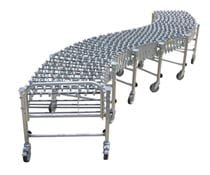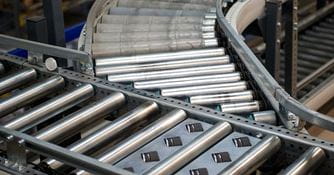Conveyor Systems | San Diego

Conveyors can greatly improve the efficiency and productivity of your warehouse while reducing labor costs.
Raymond West is the premiere warehouse automation supplier in San Diego County.
To speak with an automation expert, give us a call today at 858-679-1800.
AS/RS systems and conveyors can elevate the productivity of your distribution facilities, enhance safety practices and significantly lower employee costs.
Modern conveyors can transport everything from heavy pallets to small packages within your facility and they are an integral piece of modern material handling design.
Conveyors can be grouped in three separate divisions for the vast majority of material handling configurations:
- Powered belt or roller conveyors (for package handling).
- Powered chain or roller systems (for pallet handling).
- Non-powered conveyor systems
Powered Package Handling Roller or Belt Conveyors
Powered roller or belt conveyor systems are frequently used for smaller items like cartons and packages.
Belt systems are mostly employed for advancing products along a line, while roller systems are employed for accumulating packages in certain areas along the line.
Belt Conveyors
Used since the beginning of the 20th Century, conveyor belts are a staple of most material handling operations. Not as costly as roller conveyors and often better suited to specific tasks like advancing lightweight items, belt systems are used in many material handling designs.
Conveyor belts employ a long, looped belt that rides a metal slider belt substructure or an array of non-powered rollers. A motor drives a pulley that turns the belt and advances objects down the conveyor line.
Belts are made of a variety of surfaces and materials in accordance with the function and nature of the conveyor. For instance, a belt surface may be totally flat in areas where items need to glide off the line and may have a ridged texture on segments where products have to be transported up gradients.
Roller Conveyors
While belt conveyors still have a place in most operations, newer roller conveyors offer a number of advantages in many modern material handling uses.
Most importantly, roller systems can enable collection of products on the line where belt systems can not. This is an important contrast because there are countless scenarios where items must decelerate and accumulate in material handling applications. Common situations where accumulation is important are when objects must be paused before being relayed to sorters or palletizers.
Many roller conveyor systems also have the ability to monitor products on the line and utilize zero pressure accumulation, meaning none of the products collecting on the line touch each other as they decelerate and finally stop.
Roller conveyors are made up of numerous cylindrical rollers that are generally set up in one of these ways:.
- Line-shaft conveyors: in a line shaft system, a long steel shaft runs underneath the rollers at a right angle to them and is attached to each roller with flexible O-rings. A drive mechanism turns the shaft, and accordingly drives the cylinders by way of the attached O-rings. Line-shaft configurations are the least costly of all roller style conveyors, but they may also need the most service because the O-ring connectors between the rollers and the shaft tend to need adjustment and often fail.
- Belt-driven roller conveyors: As the name suggests, these conveyors are driven by a belt mechanism that sits beneath the roller platform. A motor drives the belt, which advances the cylinders.
- MDR conveyors: Motorized roller conveyors, sometimes referred to as motor-driven roller (MDR) conveyors, are configured in sections where a single roller from each section is powered by it's own power source. That solitary powered roller is joined to the others in that segment by way of plastic O-rings, and consequently powers all the cylinders in the section. Motorized sections are placed in sequence to create the conveyor line.
MDR conveyors are very energy efficient for a couple of reasons: a.) they usually run on 24V direct current motors and b.) the motors can be set up to run only when an object is detected on the roller cylinders, and as a result they are inactive much of the time.
Although motorized roller conveyers cost more than belt drive and line-shaft systems, electricity expenses and maintenance expenses are usually far lower than the other options mentioned. - Segmented belt conveyor: the design of motor driven roller systems ultimately inspired the birth of segmented belt conveyors. Similar to MDR systems, segmented belts are powered independently and offer several of the same advantages of MDRs, including accumulation capabilities.
Powered Pallet Handling Conveyors
Powered pallet-handling conveyors are quite often used with AS/RS systems and automatic palletizers. Pallet handling conveyors can generally deal with pallets of up to 4,000 lbs and run at a far slower pace than package handling conveyors, many times at speeds of two to four pallets per minute.
Pallet-handling conveyors come in a couple of varieties: chain conveyors and roller conveyors.
- Pallet-handling chain conveyor: perhaps the most rudimentary of all conveyor systems, pallets on a chain conveyor line are positioned directly on two or more lengths of heavy duty chain. A drive mechanism advances the chain segments which consequently move the pallets along the line.
- Pallet-handling roller conveyor: analogous to motor driven roller systems, pallet handling roller configurations use larger rollers and sturdy chains to join the motorized cylinder to the remaining cylinders in a conveyor segment.
Non-Powered Conveyors
Skatewheel or roller conveyors are the most prevalent types of non-powered conveyors used in material handling. Non-powered rollers or skatewheels use gravity or inertia to advance smaller loads though pick modules, warehouses, automated sorters, workstations, package sorting areas and loading docks.
Skatewheel systems are made up of many seperate wheels and need very little power to prolong the inertia of products as they progress along a conveyor line. In general, they advance products faster than non-powered roller configurations and they have more adaptability when it comes to configuration. Given that they're individual wheels instead of a belt, they are often applied in curved sections of a conveyor arrangement.
Generally non-powered roller systems are less expensive than skatewheel conveyor systems. They're often used for pick modules, workstations, and other zones where it's useful to maintain a level surface to perform tasks. Roller conveyors are also used to decelerate items that are coming from faster moving mechanisms like sorters so that human laborers can keep pace with system output.
Non-powered conveyors have a distinct disadvantage compared to powered conveyors: by applying gravity and inertia to move items you forego the option to directly manage the force applied to those materials. Simply put, you have minimal influence on the inertia and speed of products on your conveyor line.
Conveyor System Engineering In San Diego
If you 'd like a full analysis of conveyor system possibilities for your storage facility, DC or other material handling operation, you can speak with a professional at Raymond West by calling 858-679-1800.
Raymond West's San Diego facility serves all of San Diego County, including Carlsbad, Chula Vista, Downtown, El Cajon, Escondido, Fenton Carroll Canyon, Grantville, Kearney Mesa, Levanto, Morena, National City, Oceanside, Otay, Otay Mesa, Poway, San Marcos, Santee, Sorrento Mesa, Spring Valley, Vista and all surrounding areas.
Raymond West | San Diego Material Handling Equipment Supplier
8221 Arjons Dr # B2
San Diego, CA 92126
(858) 679-1800
You May Also Like:

Conveyor Repair | San Diego
Raymond West is a San Diego warehouse automation equipment supplier. We offer repair and service for many types of conveyor systems. Call us today at (858) 679-1800.
Learn More

Flexible Conveyors
Flexible conveyors are an ideal solution for fast moving warehouses. Raymond West is the among the top warehouse automation suppliers in the region. Give us a call today!
Learn More

Sortation Systems | San Diego
Raymond West supplies a full range of conveyor and automation products, including all types of sortation solutions. To speak with a Raymond automation expert, phone us at 858-679-1800.
Learn More

Warehouse Automation
Warehouse costs are skyrocketing. Smart warehouse operators are squeezing every last dollar out of their facilities though increased density and automation technology.
Learn More

